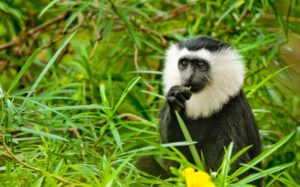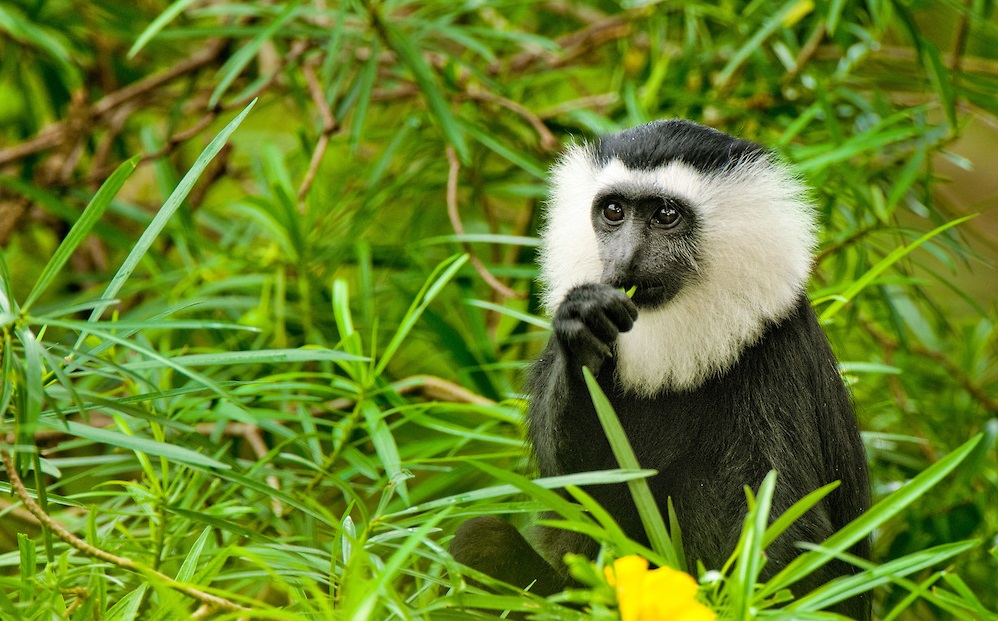The Boabeng Fiema Monkey Sanctuary (BFMS) is one of Ghana’s most distinguished examples of Traditional African Conservation Practice site. For more than 150 years, the people of Boabeng and Fiema have considered the monkeys sacred and as such revere their presence. The two monkey species that occupy BFMS are; the Black-and-White Colobus (Colobus vellerosus, a threatened species endemic to Upper Guinean Forest) and Mona monkey (Cercopithecus campbelli). These monkeys are protected and revered as “children of the gods” by historical cultural beliefs. Over many generations, a harmonious relationship has existed between the indigenous people and the monkeys such that dead monkeys are buried with elaborate rituals akin to those of humans. It is a widely held belief that anybody that intentionally kills a monkey suffers a calamity. To add to the taboo and myth, farming on Fridays has been barred in reverence to the monkeys.
The project Area (BFMS) is located between Techiman and Kintompo in the Brong-Ahafo Region of Ghana. It is characterized by forest and savanna woodland vegetation located in the Nkoranza North District in Ghana (7°42′N, 1°41′W). The main fringed communities within and around the BFMS are mainly subsistent farmers in yam, maize, vegetables and other food crops. Charcoal production for sales and fuel-wood is, however, another important occupation for the local people.

BFMS until recently enjoyed technical support from the Ghana Wildlife Division and the combination of state laws and indigenous management appeared to be effective in managing the site. This recent lack of support has led to weak ecological monitoring at the sanctuary as well as other rising undesirable anthropogenic activities that threaten the sanctuary. The situation is made worse by the recent settlement of other religious groups around the sanctuary who disregards the age-old conservation taboos that protect the species and their habitat. It is therefore feared that the persistence of these threats without an immediately and/or appropriate conservation interventions put in place, the species could lose their delicate habitat and eventually go on extinction.
Given the importance of bio-monitoring activities for effective planning, co-management, education on-site and Collaborative Resource Management (CRM), AiG launched the project titled ‘Strengthening Indigenous and Modern Conservation Practice for flagship Species in Ghana: Insight from Boabeng-Fiema Monkey Sanctuary’ funded by the New England Biolabs Foundation in August 2016. The project featured several components including local stakeholder engagements, training and capacity building for selected community members and sanctuary management staff, assessment and research surveys for current population estimates of primates and their associated habitat, promoted agroforestry practices and tree nursery establishment and planting, community and schools’ outreaches as well as conservation awareness campaigns using traditional and modern conservation protocols.
Training Activities: Training and capacity building of selected community members and sanctuary managers in survey and monitoring was carried out successfully. With the support of the Ghana Wildlife Division, we have trained a total of sixteen (16) local sanctuary managers and youth volunteers in simple bio-monitoring survey protocols. Several training days including field visits and practical experiences were undertaken to provide pragmatic and hands on practices on training modules in primate ecology, basic population and research surveys, use of survey equipment (binoculars, GPS, Compass Camera traps etc), community conservation management and ecotourism, conflict resolution and benefit sharing. The expectations of trainees were met as their capacity, technical know-how and proficiency were sharpened and shaped by the training component. So far, we are quiet impress with the rate at which the trained staffs are contributing their leadership and acquired skills to the overall success of the project and sanctuary management.
Field Research Surveys: In partnership with selected sanctuary trainees and local managers, we carried-out an assessment and study on the current population status of the primate species harboring the sanctuary. This research survey was much appreciated by the sanctuary managers as it provided baseline data on primate population and habitat suitability, and more insight on training protocols taught. The realized
data/information will be used as a proxy to measure future changes in density and distribution of primate populations in the Boabeng-Fiema Monkey Sanctuary.
Direct observation made during the survey includes; sighting the Black and White Colobus monkeys which mostly live high up in the trees eating just leaves while the Mona monkeys are at lower heights, eating a wide variety of food, including food brought by visitors. The Mona monkeys moved in troupes of 15-30 individuals usual with high counts of juveniles, came down to take food like groundnuts, bread and bananas from the hands of visitors. The Colobus monkeys were observed to be very shy and hardly came close to the research team and visitors unlike the Monas. During the field surveys, the team spotted Patas monkey, Spot-nosed monkey and Diana monkeys. Upon consultation with local managers, it was revealed that the new species we spotted and recorded were from neighboring forests and occasionally visited the sanctuary to forage. One of the striking observation made suggests that the primate population is outgrowing the caring capacity of the sanctuary as the sanctuary is under growing human pressures.
Habitat Assessment: The project also combed the study area to identify degraded areas by virtue of anthropological activities. The degree/levels of damage were also recorded.
We surveyed and identified planting sites that are likely to benefit the primate and ecological wildlife in the sanctuary. Fast growing Indigenous tree seedlings like (Ofram (Terminalia superba) Wawa (Triplochiton scleroxylon) Ceiba (Ceiba pentandra), Mahogany (Khaya ivorensis), Emeri (Terminalia ivorensis)) were selected to be planted in collaboration with trainees, farmers and fringed communities.
We identified and agreed with the sanctuary managers and traditional chiefs on selected degraded sites in the sanctuary to be replanted. Tree nurseries will be established to reclaim or restore degraded areas in the just began raining season within the sanctuary. Indigenous tree seedlings will be raised and distributed to farmers fringing the resource reserve to plant in agroforestry fashion in order to increase carbon stocks and restore the ecological integrity of the sanctuary. Abandoned farm lands in the sanctuary and other river paths outside the sanctuary that provide migratory corridor for other species will be also planted.
Also communities have been engaged and educated on sustainable sanctuary uses, climate smart agriculture and agroforestry practices, which are currently being adopted by fringed communities for farming. Forest fuel-wood harvesters and charcoal burners have also been identified and trained on wise use of the forest, alternative livelihood and ecological friendly economic activities (eg woodlot plantation and farms for fuel-wood harvesters and small ruminants farming).
Conservation Education and Awareness Campaign: Another successful component was the sensitization and awareness creation campaigns that changed mindsets and shifted attitudes and behaviors of people towards the conservation of the resource.
Prior to the conservation education and communities’ engagement activities, the team paid a courtesy visit to the traditional leaders and local authorities that own the sanctuary to solicit their support. The project team held series of meetings and interviews with the traditional authorities on their key indigenous believes, taboos and norms that were much cherished by the local communities for conserving the sanctuary and the need to be strengthened and used during our outreach programs. In fact, all the chiefs and elders in the communities contributed immensely to the success of all our consultative meetings and were always present for all the meetings. They also furnished us with much information on their interesting and useful indigenous conservation information, norms, taboos and believes that were unknown to us.
The team then proceeded as scheduled, with weekly and monthly education campaigns in the schools, house-to-house, local durbar gathering, religious group campaigns and community radio talks and night video shows. These planned activities were much welcomed by the locals and gained massive attention in the target communities.
In the instance of the schools behavior change education program, key activities such as community resources and primate conservation videos were shown to educate the children, quizzes, local conservation drama activities, poetry recital, setting-up of school environmental club, and site seeing trips to the sanctuary were organized to steer up their desire for conservation.
Our selected trainees and volunteers from the communities also took charge of the house-to-house education, religious groups engagements and youth activities. This was
followed by regular gatherings where all the chiefs and elders, traditional priest and community members met to be educated and re-ignite their conservation passion and support using their old-age folk-laws, traditional games, taboos, culture and story telling (called ‘By the Fire Side’ and/or “Ananse S3m” in the local language). What made these events highly participatory was that the chiefs and traditional leaders from each community chaired and coordinated all activities.
In fact, the team and other visitors were much thrilled at such a beautiful and powerful bio-cultural integrity scenes of the local people. Everyone at the scene had an opportunity to learn from the cultural activities they did together with us including drama sketches on primate and wildlife conservation.
Recommendation
The project needs to be monitored on a regular basis to ensure short term and long-term goals are sustained after end of the project. Conscious efforts should be made to expand and upscale the project to achieve maximum conservation benefits. Project has also set the stage and/or served as a unique model in Ghana about the potential indigenous people have in protecting their resources sustainably when given the right support and training. It is recommended that further ecological studies be conducted to assess the caring capacity of the sanctuary in relation to population growth of the primates and increasing human pressure on the resources. In fact the BFMS in its unique state has not realized its ecotourism potential well enough. Hence it is recommended that the government, local and international partners come together and explore and promote the ecotourism potential of the Boabeng Fiema Sanctuary.
We would like to thank New England Biolabs Foundation for providing the financial support to conduct the project. We are also very much indebted to the Traditional Authorities, Ghana Wildlife Division, Kwame Nkrumah University of Science and Technology (KNUST) for its continuous support for the project.
Similarly, we are thankful to Dr. Bright Kankam of Forestry Research Institute of Ghana (FORIG) under the Council for Scientific and Industrial Research (CSIR) for
the support during the various training and research activities.
We would like to thank all the BFMS sanctuary mangers, community members, community school management, and all project volunteers involved directly and indirectly in the project activities. Finally we are thankful to all the staffs of AiG and partners for providing support at their level to accomplish the project successfully.

